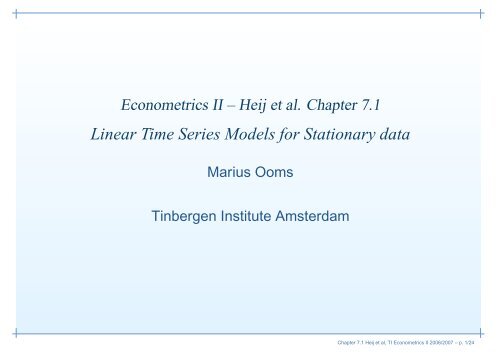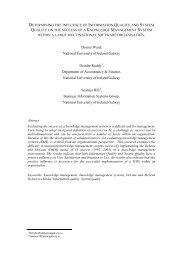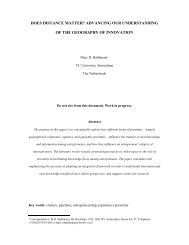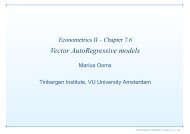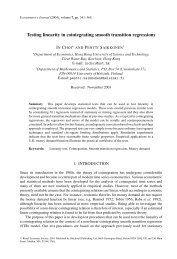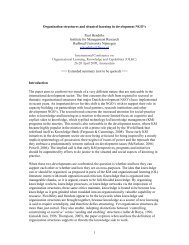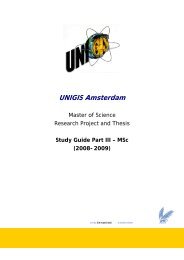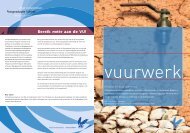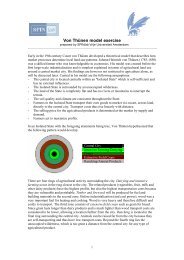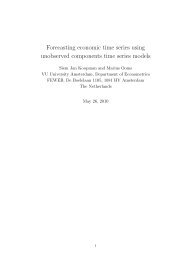Linear Time Series Models for Stationary data - Feweb
Linear Time Series Models for Stationary data - Feweb
Linear Time Series Models for Stationary data - Feweb
You also want an ePaper? Increase the reach of your titles
YUMPU automatically turns print PDFs into web optimized ePapers that Google loves.
Econometrics II – Heij et al. Chapter 7.1<br />
<strong>Linear</strong> <strong>Time</strong> <strong>Series</strong> <strong>Models</strong> <strong>for</strong> <strong>Stationary</strong> <strong>data</strong><br />
Marius Ooms<br />
Tinbergen Institute Amsterdam<br />
Chapter 7.1 Heij et al, TI Econometrics II 2006/2007 – p. 1/24
Program<br />
• Introduction Modelling philosophy <strong>Time</strong> <strong>Series</strong> Analysis<br />
• <strong>Time</strong> series concepts and models <strong>for</strong> stationary time series<br />
◦ Stationarity, White Noise, Random Walk<br />
◦ Correlogram, ACF<br />
◦ Lags, differences and lag polynomials<br />
◦ <strong>Linear</strong> stochastic processes<br />
Chapter 7.1 Heij et al, TI Econometrics II 2006/2007 – p. 2/24
Introduction Macroeconometrics and ARIMA models<br />
Often, <strong>for</strong> (short run) <strong>for</strong>ecasting purposes, a simple model that<br />
describes the behaviour of a single variable (or a small set of<br />
variables) in terms of its own past values is satisfactory.<br />
Research shows that simple, linear univariate (ARIMA) time-series<br />
models based on just a few parameters often have a better <strong>for</strong>ecasting<br />
per<strong>for</strong>mance than larger multivariate dynamic simultaneous-equations<br />
models (SEM), especially <strong>for</strong> aggregated <strong>data</strong> like macroeconomic<br />
series. Zellner and Palm, (JoE (1974, pp 17-54)), provide a rationale<br />
<strong>for</strong> this: each single variable from a joint linear dynamic SEM, §7.7.2,<br />
or VAR, follows a marginal linear univariate ARIMA process, see<br />
§7.6.1. An ARIMA model does not accumulate misspecifications<br />
related to different equations and variables as in a multivariate<br />
dynamic SEM.<br />
Chapter 7.1 Heij et al, TI Econometrics II 2006/2007 – p. 3/24
ARIMA Model building<br />
In section §7.1 - §7.3, we study tools of linear analysis of time-series<br />
<strong>data</strong> starting with key concepts in §7.1. Model building philosophy is<br />
now specific to general with cycles:<br />
1. Trans<strong>for</strong>m <strong>data</strong> to stationarity §7.3 (logs, differences, breaks)<br />
2. Identify a parsimonious ARIMA model <strong>for</strong> stationary series,<br />
comparing model and <strong>data</strong> characteristics, §7.1.3- §7.1.5, §7.2.3<br />
3. Estimate ARIMA model §7.2.2<br />
4. Test ARMA model model, §7.2.4. If not OK, restart with 1. or 2.<br />
5. Forecast with ARIMA model §7.1.6, §7.2.4 : conditional mean and<br />
variance, one-step and multi-step<br />
Chapter 7.1 Heij et al, TI Econometrics II 2006/2007 – p. 4/24
Key concepts of linear time series analysis<br />
Stationarity, second order / weak<br />
A stochastic process yt is said to be stationary in mean and variance,<br />
when the following conditions are satisfied:<br />
E(yt) = µ, Cov(yt, yt−k) = γk,<br />
<strong>for</strong> any t (that is, <strong>for</strong> any position in the time series) and <strong>for</strong><br />
k = 0, 1, 2, . . ..<br />
This defines second order (weak) stationarity.<br />
Chapter 7.1 Heij et al, TI Econometrics II 2006/2007 – p. 5/24
Dow Jones: Nonstationary series<br />
Dow Jones Index Industrials Weekly 1896-2004<br />
12000<br />
10000<br />
8000<br />
6000<br />
4000<br />
2000<br />
0<br />
1900 1925 1950 1975 2000<br />
DJIND<br />
Chapter 7.1 Heij et al, TI Econometrics II 2006/2007 – p. 6/24
Key concept: SACF, White Noise (WN)<br />
Consistent estimates <strong>for</strong> mean, variance and covariances <strong>for</strong> weakly<br />
stationary processes are obtained as follows:<br />
µ = ¯y, γk = 1<br />
n<br />
n<br />
t=k+1<br />
(yt − ¯y)(yt−k − ¯y).<br />
γk, k = 0, 1, 2, . . . is the sample autocovariance function (SACF).<br />
Simplest example of a stationary series is a White Noise process<br />
(WN) which we denote as εt. WN is a sequence of uncorrelated<br />
random variables with constant mean and variance:<br />
γ0 = σ 2 ε, γk = 0, k = 1, 2, . . ..<br />
Chapter 7.1 Heij et al, TI Econometrics II 2006/2007 – p. 7/24
Key concept: Random Walk (RW)<br />
Best known economic example of a weakly nonstationary series is a<br />
Random Walk Process (RW). RW is the partial sum process of a WN<br />
sequence:<br />
t<br />
εj t = 1, 2, . . ..<br />
ut =<br />
j=1<br />
The variance (conditional on starting values) of ut increases (linearly)<br />
with t, even if t → ∞, contradicting stationarity condition <strong>for</strong> variance.<br />
Exercise (1) Derive this result.<br />
Chapter 7.1 Heij et al, TI Econometrics II 2006/2007 – p. 8/24
Log Dow Jones: Nonstationary series<br />
Log trans<strong>for</strong>med Dow Jones Index Industrials Weekly 1896-2004.<br />
Exercise (2): approximate mean weekly growth using the in<strong>for</strong>mation<br />
from this graph. Does the outcome make sense?.<br />
10<br />
9<br />
8<br />
7<br />
6<br />
5<br />
4<br />
3<br />
1900 1925 1950 1975 2000<br />
LOG(DJIND)<br />
Chapter 7.1 Heij et al, TI Econometrics II 2006/2007 – p. 9/24
Returns (DLog) DJI: Nonstationary series?<br />
Returns Dow Jones Index Industrials Weekly 1896-2004<br />
.3<br />
.2<br />
.1<br />
.0<br />
-.1<br />
-.2<br />
-.3<br />
-.4<br />
1900 1925 1950 1975 2000<br />
DLOG(DJIND)<br />
Chapter 7.1 Heij et al, TI Econometrics II 2006/2007 – p. 10/24
Autocovariance, -correlation, correlogram<br />
In ARIMA modelling, autocovariance is the main <strong>data</strong> characterstic to<br />
be modelled. It is not a nuisance, but the object of study. Systematic<br />
autocovariances entail <strong>for</strong>ecastability!<br />
The autocovariance function, γk, is seen as a function of lag k. One<br />
often plots the autocorrelation function which has the same shape<br />
and contains the same in<strong>for</strong>mation on the dynamics, but is<br />
dimensionless:<br />
ρk = γk<br />
γ0<br />
, k = 1, 2, . . ..<br />
Consistent estimates <strong>for</strong> weakly stationary processes are obtained by<br />
ρk = rk = γk<br />
,<br />
γ0<br />
a plot of these against k = 1, 2, . . . is known as the correlogram.<br />
Chapter 7.1 Heij et al, TI Econometrics II 2006/2007 – p. 11/24
Identification / Data Analysis<br />
The sample characteristics of a time series should match the<br />
(theoretical) population characteristics of the statistical time series<br />
model. In the identification stage we choose a (unique) model<br />
corresponding to the observed characteristics.<br />
<strong>Time</strong> series plots and correlograms are the main tools <strong>for</strong> analysing<br />
the empirical properties of time series.<br />
It is often illuminating to consider (partial) scatter plots of yt versus<br />
yt−k in the context of the linear, infinite order autoregressive,<br />
(one-step-ahead) prediction decomposition of a time series process.<br />
See also §5.5, where similar techniques were applied as diagnostic<br />
tools on residuals after a first model was estimated.<br />
Chapter 7.1 Heij et al, TI Econometrics II 2006/2007 – p. 12/24
Scatter plot log weekly Dow Jones vs. lagged value<br />
Log Dow Jones Index Industrials Weekly 1896-2004. ’Autoregression’<br />
scatterplot.<br />
LOG(DJIND)<br />
10<br />
9<br />
8<br />
7<br />
6<br />
5<br />
4<br />
3<br />
3 4 5 6 7 8 9 10<br />
LOG(DJIND(-1))<br />
Chapter 7.1 Heij et al, TI Econometrics II 2006/2007 – p. 13/24
Scatter plot dlog Dow Jones vs lagged<br />
Returns (dlog) Dow Jones Index Industrials Weekly 1896-2004.<br />
Autoregression’ scatterplot.Autoregression’ scatterplot.Autoregression’<br />
scatterplot.<br />
DLOG(DJIND)<br />
.3<br />
.2<br />
.1<br />
.0<br />
-.1<br />
-.2<br />
-.3<br />
-.4<br />
-.4 -.3 -.2 -.1 .0 .1 .2 .3<br />
DLOG(DJIND(-1))<br />
Chapter 7.1 Heij et al, TI Econometrics II 2006/2007 – p. 14/24
AR(∞) representation<br />
A simple idea <strong>for</strong> linear <strong>for</strong>ecasting is to (auto)regress yt on its own<br />
lags, employing all the (partial) linear correlations of yt with its past.<br />
Infinite order Autoregressive representation:<br />
yt = E[yt|Yt−1] + εt<br />
E[yt|Yt−1] = α + π1yt−1 + π2yt−2 + . . . (7.2)<br />
E[(yt − µ)|Yt−1] = π1(yt−1 − µ) + π2(yt−2 − µ) + . . . + εt<br />
where α is a constant so that<br />
(1 − πk) −1 α = µ is the constant perfectly predictable<br />
deterministic part,<br />
π1(yt−1 − µ) + (π2 − µ)yt−2 + . . . is the (linearly) predictable<br />
stochastic part, and<br />
εt is the unpredictable innovation part or prediction error, satisfying<br />
the White Noise condition.<br />
Exercise (3): Using stationarity of yt, show E(yt) = µ = α<br />
1− πk .<br />
Chapter 7.1 Heij et al, TI Econometrics II 2006/2007 – p. 15/24
AR(20) Log Dow Jones<br />
Log Dow Jones Index Industrials Weekly 1896-2004<br />
Dependent Variable: LOGDJIND<br />
Method: Least Squares<br />
Date: 02/05/04 <strong>Time</strong>: 16:10<br />
Sample(adjusted): 3/24/1897 1/27/2004<br />
Included observations: 5576 after adjusting endpoints<br />
Variable Coefficient Std. Error t-Statistic Prob.<br />
C 0.000576 0.001420 0.405789 0.6849<br />
LOGDJIND(-1) 1.019829 0.013412 76.03649 0.0000<br />
LOGDJIND(-2) 0.024193 0.019158 1.262802 0.2067<br />
LOGDJIND(-3) -0.028221 0.019144 -1.474136 0.1405<br />
LOGDJIND(-4) -0.027416 0.019114 -1.434339 0.1515<br />
LOGDJIND(-5) 0.001765 0.019090 0.092460 0.9263<br />
LOGDJIND(-6) 0.017536 0.019086 0.918799 0.3582<br />
LOGDJIND(-7) 0.005282 0.019081 0.276802 0.7819<br />
LOGDJIND(-8) -0.034464 0.019080 -1.806301 0.0709<br />
LOGDJIND(-9) 0.050894 0.019081 2.667203 0.0077<br />
LOGDJIND(-10) -0.024129 0.019091 -1.263928 0.2063<br />
LOGDJIND(-11) -0.021337 0.019091 -1.117659 0.2638<br />
LOGDJIND(-12) 0.020287 0.019070 1.063788 0.2875<br />
LOGDJIND(-13) -0.007611 0.019065 -0.399203 0.6898<br />
LOGDJIND(-14) -0.019612 0.019065 -1.028677 0.3037<br />
LOGDJIND(-15) 0.013889 0.019065 0.728512 0.4663<br />
LOGDJIND(-16) -0.013786 0.019066 -0.723046 0.4697<br />
LOGDJIND(-17) 0.072059 0.019054 3.781789 0.0002<br />
LOGDJIND(-18) -0.059659 0.019080 -3.126773 0.0018<br />
LOGDJIND(-19) -0.015096 0.019095 -0.790558 0.4292<br />
LOGDJIND(-20) 0.025666 0.013361 1.920898 0.0548<br />
R-squared 0.999700 Mean dependent var 5.919391<br />
Adjusted R-squared 0.999699 S.D. dependent var 1.496886<br />
S.E. of regression 0.025960 Akaike info criterion -4.460732<br />
Sum squared resid 3.743740 Schwarz criterion -4.435777<br />
Log likelihood 12457.52 F-statistic 926489.2<br />
Durbin-Watson stat 1.998905 Prob(F-statistic) 0.000000<br />
Chapter 7.1 Heij et al, TI Econometrics II 2006/2007 – p. 16/24
AR(20) (+trend) Log Dow Jones<br />
Log Dow Jones Index Industrials Weekly 1896-2004<br />
Dependent Variable: LOGDJIND<br />
Method: Least Squares<br />
Date: 02/05/04 <strong>Time</strong>: 16:32<br />
Sample(adjusted): 3/24/1897 1/27/2004<br />
Included observations: 5576 after adjusting endpoints<br />
Variable Coefficient Std. Error t-Statistic Prob.<br />
C 0.005196 0.002740 1.896455 0.0580<br />
T 1.41E-06 7.13E-07 1.971410 0.0487<br />
LOGDJIND(-1) 1.019106 0.013414 75.97385 0.0000<br />
LOGDJIND(-2) 0.024200 0.019153 1.263498 0.2065<br />
LOGDJIND(-3) -0.028143 0.019139 -1.470451 0.1415<br />
LOGDJIND(-4) -0.027432 0.019109 -1.435569 0.1512<br />
LOGDJIND(-5) 0.001766 0.019085 0.092521 0.9263<br />
LOGDJIND(-6) 0.017515 0.019081 0.917944 0.3587<br />
LOGDJIND(-7) 0.005277 0.019076 0.276605 0.7821<br />
LOGDJIND(-8) -0.034449 0.019075 -1.805995 0.0710<br />
LOGDJIND(-9) 0.050860 0.019076 2.666130 0.0077<br />
LOGDJIND(-10) -0.024108 0.019086 -1.263142 0.2066<br />
LOGDJIND(-11) -0.021308 0.019086 -1.116404 0.2643<br />
LOGDJIND(-12) 0.020246 0.019065 1.061934 0.2883<br />
LOGDJIND(-13) -0.007609 0.019060 -0.399232 0.6897<br />
LOGDJIND(-14) -0.019612 0.019060 -1.028949 0.3035<br />
LOGDJIND(-15) 0.013859 0.019060 0.727116 0.4672<br />
LOGDJIND(-16) -0.013814 0.019061 -0.724709 0.4687<br />
LOGDJIND(-17) 0.072054 0.019049 3.782509 0.0002<br />
LOGDJIND(-18) -0.059585 0.019075 -3.123700 0.0018<br />
LOGDJIND(-19) -0.015090 0.019090 -0.790459 0.4293<br />
LOGDJIND(-20) 0.024892 0.013364 1.862693 0.0626<br />
R-squared 0.999701 Mean dependent var 5.919391<br />
Adjusted R-squared 0.999699 S.D. dependent var 1.496886<br />
S.E. of regression 0.025954 Akaike info criterion -4.461073<br />
Sum squared resid 3.741122 Schwarz criterion -4.434930<br />
Log likelihood 12459.47 F-statistic 882829.4<br />
Durbin-Watson stat 1.998889 Prob(F-statistic) 0.000000<br />
Chapter 7.1 Heij et al, TI Econometrics II 2006/2007 – p. 17/24
AR(20) dLog Dow Jones<br />
Returns (dlog) Dow Jones Index Industrials Weekly 1896-2004<br />
Dependent Variable: DLOGDJIND<br />
Method: Least Squares<br />
Date: 02/05/04 <strong>Time</strong>: 16:11<br />
Sample(adjusted): 3/31/1897 1/27/2004<br />
Included observations: 5575 after adjusting endpoints<br />
Variable Coefficient Std. Error t-Statistic Prob.<br />
C 0.000964 0.000352 2.735265 0.0063<br />
DLOGDJIND(-1) 0.020379 0.013416 1.519045 0.1288<br />
DLOGDJIND(-2) 0.044236 0.013414 3.297873 0.0010<br />
DLOGDJIND(-3) 0.014778 0.013425 1.100752 0.2711<br />
DLOGDJIND(-4) -0.011092 0.013408 -0.827272 0.4081<br />
DLOGDJIND(-5) -0.009720 0.013402 -0.725309 0.4683<br />
DLOGDJIND(-6) 0.008131 0.013385 0.607450 0.5436<br />
DLOGDJIND(-7) 0.013087 0.013379 0.978222 0.3280<br />
DLOGDJIND(-8) -0.021609 0.013379 -1.615144 0.1063<br />
DLOGDJIND(-9) 0.029758 0.013382 2.223753 0.0262<br />
DLOGDJIND(-10) 0.005215 0.013385 0.389629 0.6968<br />
DLOGDJIND(-11) -0.016651 0.013385 -1.243954 0.2136<br />
DLOGDJIND(-12) 0.004730 0.013382 0.353478 0.7237<br />
DLOGDJIND(-13) -0.003570 0.013365 -0.267144 0.7894<br />
DLOGDJIND(-14) -0.023138 0.013362 -1.731686 0.0834<br />
DLOGDJIND(-15) -0.008880 0.013364 -0.664465 0.5064<br />
DLOGDJIND(-16) -0.022613 0.013359 -1.692672 0.0906<br />
DLOGDJIND(-17) 0.048747 0.013360 3.648812 0.0003<br />
DLOGDJIND(-18) -0.011406 0.013374 -0.852851 0.3938<br />
DLOGDJIND(-19) -0.025999 0.013360 -1.946003 0.0517<br />
DLOGDJIND(-20) 0.020418 0.013361 1.528155 0.1265<br />
R-squared 0.008920 Mean dependent var 0.001019<br />
Adjusted R-squared 0.005351 S.D. dependent var 0.026027<br />
S.E. of regression 0.025957 Akaike info criterion -4.460958<br />
Sum squared resid 3.742220 Schwarz criterion -4.435999<br />
Log likelihood 12455.92 F-statistic 2.499356<br />
Durbin-Watson stat 2.000775 Prob(F-statistic) 0.000233<br />
Chapter 7.1 Heij et al, TI Econometrics II 2006/2007 – p. 18/24
Practical purpose of linear time series analysis<br />
If yt is stationary, a nearly standard regression interpretation of (7.2)<br />
applies.<br />
We strive to minimize the variance and remove serial correlation in<br />
the “error term”, εt, using parsimonious linear models <strong>for</strong> the<br />
deterministic part and the predictable stochastic part of yt.<br />
Exercise (4): Show that the Durbin-Watson statistic is a consistent<br />
estimator of 2(1 −ρ1), c.f. §5.5.3. Which of the three regression models<br />
above is optimal in this respect using standard regression criteria?<br />
Chapter 7.1 Heij et al, TI Econometrics II 2006/2007 – p. 19/24
Essential time series algebra: lag operators<br />
Lags, differences and lag polynomials<br />
Heij et al. (2004) make intensive use of lag polynomials. It is<br />
important to understand the mechanics of lag polynomials to<br />
understand Heij et al. (2004) and to understand the literature. Note the<br />
relationship with differential equations in, (e.g.), Davis and Bimmore<br />
(2001). See notes <strong>for</strong> connection between Heij and TI Mathematics<br />
course.<br />
The lag operator L is essential in time series algebra:<br />
Lyt = yt−1, L k yt = yt−k, L 0 = 1, L −k yt = yt+k (lead).<br />
The first difference operator is:<br />
Second differences:<br />
∆ = 1 − L, ∆yt = yt − yt−1.<br />
∆ 2 = ∆∆ = 1 − 2L + L 2 .<br />
Chapter 7.1 Heij et al, TI Econometrics II 2006/2007 – p. 20/24
Lag polynomials<br />
Examples of lag polynomials are<br />
φ(L) = 1 − φ1L − φ2L 2 − . . . − φpL p ,<br />
θ(L) = 1 + θ1L + θ2L 2 + . . . + θqL q ,<br />
where p and q are some fixed maximum lag values.<br />
The set of lag polynomials φ(L) is isomorphic to the set of algebraic<br />
polynomials φ(z), with z ∈ C, |z| ≤ 1: the computational properties<br />
(multiplication, division, addition, subtraction) of standard polynomials<br />
in the variable z apply also to polynomials in the lag operator L.<br />
The inverse of a lag polynomial φ −1 (L) is the polynomial so that<br />
φ −1 (L)φ(L) = 1. Note that 1 is the “neutral element” of the<br />
multiplication of polynomials.<br />
Compare the definition of the inverse of a square matrix, find A −1 such<br />
that A −1 A = I.<br />
Chapter 7.1 Heij et al, TI Econometrics II 2006/2007 – p. 21/24
Inverse of lag polynomial, details<br />
In mathematical notation:<br />
φ −1 (z) · φ(z) = 1 =<br />
. . . + 0 · z −2 + 0 · z −1 + 1 · z 0 + 0 · z 1 + 0 · z 2 + . . .<br />
Example: φ(L) = 1 − φL<br />
(1 − φL) −1 = 1L 0 + φL + φ 2 L 2 + . . .<br />
= ∞<br />
j=0 φj L j<br />
A rational lag polynomial φ −1 (L)θ(L) is defined analogously.<br />
Exercise (5): Derive the first 4 terms of (1 − φ1L − φ2L 2 ) −1 .<br />
Chapter 7.1 Heij et al, TI Econometrics II 2006/2007 – p. 22/24
<strong>Linear</strong> Stochastic processes, Wold representation<br />
An other important theoretical motivation <strong>for</strong> ARIMA modelling is the<br />
Wold representation theorem (proof omitted):<br />
The stochastic part of any zero-mean weakly stationary process yt<br />
can be represented as an (MA(∞)) process:<br />
yt =<br />
∞<br />
j=0<br />
ψjεt−j,<br />
with εt WN, where ψ0, ψ1, ψ2, . . . are parameters <strong>for</strong> which<br />
∞<br />
j=0<br />
ψ 2 j < ∞, or<br />
∞<br />
|ψj| < ∞,<br />
so that we obtain a finite variance and finite covariances indeed:<br />
γk = E[ytyt−k] = E[<br />
∞<br />
j=0<br />
ψjεt−j<br />
∞<br />
h=0<br />
j=0<br />
ψhεt−h−k] = σ 2 ε<br />
∞<br />
h=0<br />
ψk+hψh<br />
Chapter 7.1 Heij et al, TI Econometrics II 2006/2007 – p. 23/24
Limitations of MA(∞) and AR(∞) representations<br />
The Wold representation theorem states that any stationary process<br />
can be written as the sum of a deterministic (perfectly <strong>for</strong>ecastable)<br />
part and a purely stochastic MA(∞) process.<br />
Neither the MA(∞) representation, nor the AR(∞) representation are<br />
useful in practice as it is impossible to estimate all the parameters<br />
from a finite sample.<br />
Summary<br />
The main properties of a linear stochastic process are expressed in the<br />
autocovariance function.<br />
All stationary (purely) stochastic linear processes can be written as an<br />
MA(∞) process, which is efficiently approximated by the ARMA<br />
model. The ARMA model provides a parsimonious (i.e. using few<br />
parameters) rational (i.c. by a ratio of two lag polynomials)<br />
approximation <strong>for</strong> ψ(L) or π(L).<br />
In practice the theoretical autocovariance function of an ARMA model<br />
must match the empirical autocovariance function.<br />
Chapter 7.1 Heij et al, TI Econometrics II 2006/2007 – p. 24/24


